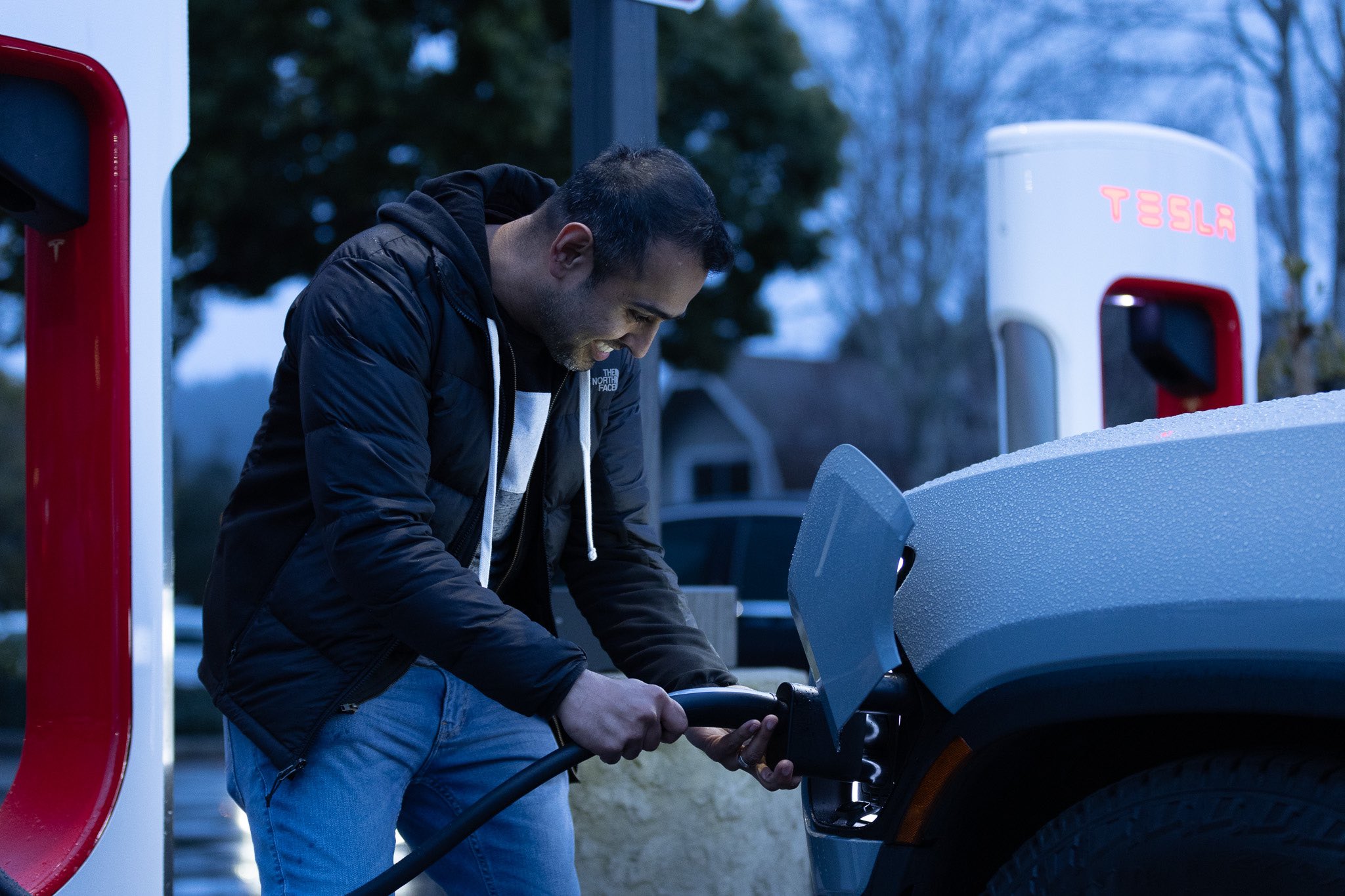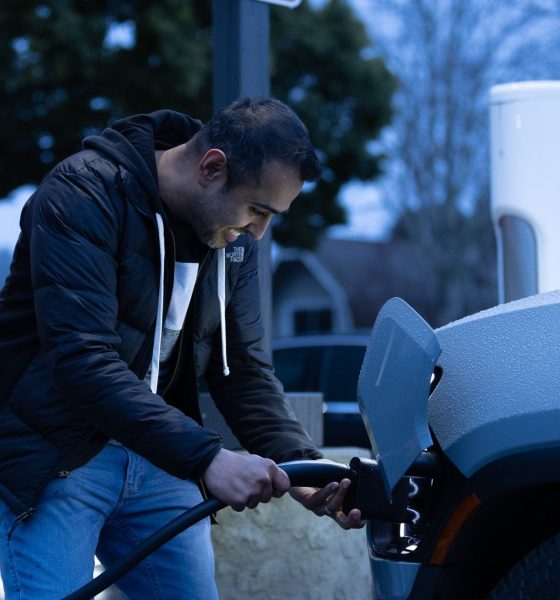

News
Non-Tesla Supercharger program gets its first tests — it’s ease of use is fantastic
Several videos featuring the non-Tesla Supercharger program have emerged, showing just how easy it is to charge electric cars at the company’s rapid charging network. Among the first videos that have been shared online featured a Rivian R1T and a Ford F-150 Lightning connecting and charging at a Tesla Supercharger.
The non-Tesla Supercharger program has been launched in the United States, allowing electric vehicle owners to take advantage of the EV maker’s fast and reliable EV charging infrastructure. Even with its Magic Dock system, the process to connect Superchargers for non-Teslas is simple.
Tesla is all inclusive, welcoming every EV to its network! @elonmusk pic.twitter.com/s83ty5bNyz
— Tesla Raj (@tesla_raj) March 1, 2023
As noted by the EV maker in a recently shared video on its official Tesla Charging Twitter account, users just have to select a Supercharger station and stall through the Tesla App. After this, users could undock the Superchargers’ Magic Dock and connect to their vehicles.
Magic dock process to charge the rivian on @TeslaCharging supercharger pic.twitter.com/TlwFAAk1k4
— Anthony H (@anthonyhensonev) March 1, 2023
This simplicity was showcased by a Rivian R1T owner who demonstrated how his all-electric pickup truck charged at a Tesla Supercharger. It only took a few seconds to connect the R1T to the Supercharger stall. The speed was decent too, with the Supercharger providing about 150 kW of power to the all-electric pickup truck.
BREAKING: A Ford F150 lightning plugs into the Tesla Supercharger at Scott’s Valley. Super easy process and very exciting time. 🤯🤯 @tesla @elonmusk @TeslaCharging pic.twitter.com/U0Aup2TnR6
— Tesla Owners Silicon Valley (@teslaownersSV) March 1, 2023
The same ease of use was observed by a Ford F-150 Lightning owner who used a Supercharger at Scott’s Valley in California. Similar to the experience of the R1T owner, the Ford F-150 Lightning user’s experience practically seamless. The Magic Dock system may not be as simple as connecting a Tesla to a Supercharger, but it is notably easier compared to other mainstream EV charging systems.
Charging an EV?
It’s as easy as 1. 2. 3… 4 pic.twitter.com/d2e2hjL9Ea— The Kilowatts 🚗⚡️ (@klwtts) January 26, 2023
The non-Tesla Supercharger program has the advantage to become a game-changer in the United States. The US’ existing EV charging infrastructure outside the Supercharger Network is not exactly extremely reliable, after all, and some are quite inconvenient to use. This was demonstrated by EV group The Kilowatts in a social media post, which outlined the differences between charging an EV with a Tesla Supercharger and Electrify America.
The Teslarati team would appreciate hearing from you. If you have any tips, contact me at maria@teslarati.com or via Twitter @Writer_01001101.

News
Tesla China quietly posts Robotaxi-related job listing
Tesla China is currently seeking a Low Voltage Electrical Engineer to work on circuit board design for the company’s autonomous vehicles.

Tesla has posted a new job listing in Shanghai explicitly tied to its Robotaxi program, fueling speculation that the company is preparing to launch its dedicated autonomous ride-hailing service in China.
As noted in the listing, Tesla China is currently seeking a Low Voltage Electrical Engineer to work on circuit board design for the company’s autonomous vehicles.
Robotaxi-specific role
The listing, which was shared on social media platform X by industry watcher @tslaming, suggested that Tesla China is looking to fill the role urgently. The job listing itself specifically mentions that the person hired for the role will be working on the Low Voltage Hardware team, which would design the circuit boards that would serve as the nervous system of the Robotaxi.
Key tasks for the role, as indicated in the job listing, include collaboration with PCB layout, firmware, mechanical, program management, and validation teams, among other responsibilities. The role is based in Shanghai.
China Robotaxi launch
China represents a massive potential market for robotaxis, with its dense urban centers and supportive policies in select cities. Tesla has limited permission to roll out FSD in the country, though despite this, its vehicles have been hailed as among the best in the market when it comes to autonomous features. So far, at least, it appears that China supports Tesla’s FSD and Robotaxi rollout.
This was hinted at in November, when Tesla brought the Cybercab to the 8th China International Import Expo (CIIE) in Shanghai, marking the first time that the autonomous two-seater was brought to the Asia-Pacific region. The vehicle, despite not having a release date in China, received a significant amount of interest among the event’s attendees.
Elon Musk
Elon Musk and Tesla AI Director share insights after empty driver seat Robotaxi rides
The executives’ unoccupied tests hint at the rapid progress of Tesla’s unsupervised Robotaxi efforts.

Tesla CEO Elon Musk and AI Director Ashok Elluswamy celebrated Christmas Eve by sharing personal experiences with Robotaxi vehicles that had no safety monitor or occupant in the driver’s seat. Musk described the system’s “perfect driving” around Austin, while Elluswamy posted video from the back seat, calling it “an amazing experience.”
The executives’ unoccupied tests hint at the rapid progress of Tesla’s unsupervised Robotaxi efforts.
Elon and Ashok’s firsthand Robotaxi insights
Prior to Musk and the Tesla AI Director’s posts, sightings of unmanned Teslas navigating public roads were widely shared on social media. One such vehicle was spotted in Austin, Texas, which Elon Musk acknowleged by stating that “Testing is underway with no occupants in the car.”
Based on his Christmas Eve post, Musk seemed to have tested an unmanned Tesla himself. “A Tesla with no safety monitor in the car and me sitting in the passenger seat took me all around Austin on Sunday with perfect driving,” Musk wrote in his post.
Elluswamy responded with a 2-minute video showing himself in the rear of an unmanned Tesla. The video featured the vehicle’s empty front seats, as well as its smooth handling through real-world traffic. He captioned his video with the words, “It’s an amazing experience!”
Towards Unsupervised operations
During an xAI Hackathon earlier this month, Elon Musk mentioned that Tesla owed be removing Safety Monitors from its Robotaxis in Austin in just three weeks. “Unsupervised is pretty much solved at this point. So there will be Tesla Robotaxis operating in Austin with no one in them. Not even anyone in the passenger seat in about three weeks,” he said. Musk echoed similar estimates at the 2025 Annual Shareholder Meeting and the Q3 2025 earnings call.
Considering the insights that were posted Musk and Elluswamy, it does appear that Tesla is working hard towards operating its Robotaxis with no safety monitors. This is quite impressive considering that the service was launched just earlier this year.
Elon Musk
Starlink passes 9 million active customers just weeks after hitting 8 million
The milestone highlights the accelerating growth of Starlink, which has now been adding over 20,000 new users per day.

SpaceX’s Starlink satellite internet service has continued its rapid global expansion, surpassing 9 million active customers just weeks after crossing the 8 million mark.
The milestone highlights the accelerating growth of Starlink, which has now been adding over 20,000 new users per day.
9 million customers
In a post on X, SpaceX stated that Starlink now serves over 9 million active users across 155 countries, territories, and markets. The company reached 8 million customers in early November, meaning it added roughly 1 million subscribers in under seven weeks, or about 21,275 new users on average per day.
“Starlink is connecting more than 9M active customers with high-speed internet across 155 countries, territories, and many other markets,” Starlink wrote in a post on its official X account. SpaceX President Gwynne Shotwell also celebrated the milestone on X. “A huge thank you to all of our customers and congrats to the Starlink team for such an incredible product,” she wrote.
That growth rate reflects both rising demand for broadband in underserved regions and Starlink’s expanding satellite constellation, which now includes more than 9,000 low-Earth-orbit satellites designed to deliver high-speed, low-latency internet worldwide.
Starlink’s momentum
Starlink’s momentum has been building up. SpaceX reported 4.6 million Starlink customers in December 2024, followed by 7 million by August 2025, and 8 million customers in November. Independent data also suggests Starlink usage is rising sharply, with Cloudflare reporting that global web traffic from Starlink users more than doubled in 2025, as noted in an Insider report.
Starlink’s momentum is increasingly tied to SpaceX’s broader financial outlook. Elon Musk has said the satellite network is “by far” the company’s largest revenue driver, and reports suggest SpaceX may be positioning itself for an initial public offering as soon as next year, with valuations estimated as high as $1.5 trillion. Musk has also suggested in the past that Starlink could have its own IPO in the future.








